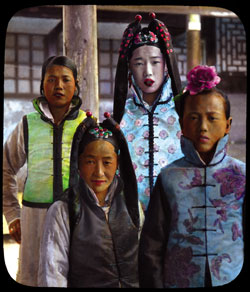
|
About The Exhibits
Thirty-nine fascinating photographs from hand-tinted lantern slides reveal the dusty glamour of camel caravans, Buddhist monasteries, local rituals, and spectacular scenery of Tibet, China, and Mongolia. The exhibit also features original documents and diaries from the expedition, plus some of the plant and animal specimens collected. This photographic exhibit is the only record of two early twentieth century explorers, Frederick and Janet Wulsin, who collected plants, animals, and artifacts on a two-year trek through the Mongolian and Tibetan borderlands of China in the early 1920s. In March 1923, the Wulsins launched their most significant expedition, a nine-month trip to central China, sponsored by the National Geographic Society. They used Graflex and then-new Kodak 4x5 cameras among other equipment to document the people and places they encountered. They developed their film in makeshift darkrooms whenever they came to a location with sufficient water. The Wulsins' expedition covered more than 750 miles along the north bank of the Yellow River, through the Alashan Desert, and finally into Gansu and Qinghai provinces to the renowned lamaseries in the highlands bordering Tibet. Difficult terrain and unstable weather conditions made for a challenging and dangerous journey along a route that itinerant merchants, religious pilgrims, and Christian missionaries traversed. Janet Wulsin's daughter is Mabel H. Cabot, who organized the exhibition and authored Vanished Kingdoms: A Woman Explorer in Tibet, China, and Mongolia 19211925, the critically acclaimed book that accompanies the exhibition. She says Janet was the chief creative force behind this remarkable collection of photographs: Sacred Portraits from Tibet The exhibit included a thangka of the four-armed Avalotitevara, the bodhisattva of compassion, painted especially for the Burke by local artist and well-known monk, Dhawa Dhondup Ngoche. One of Ngoche's own traditional Tibetan Buddhist altars was also displayed amongst the thangkas in the exhibit. Vanished Kingdoms was produced by the Peabody Essex Museum in collaboration with the Peabody Museum of Archaeology and Ethnology, Harvard University. Both exhibits are sponsored by the Blakemore Foundation with support from the Hugh and Jane Ferguson Foundation, the Sidney Fund, and the Silk Road Foundation. The Burke's presentation of these exhibits has had the active participation and approval of Tibetan religious and community leaders in Seattle. |
 Merchant's family and young brides. Frederick and Janet Wulsin |
 |
©2006 Burke Museum of Natural History and Culture. |